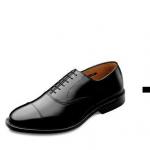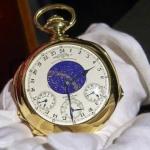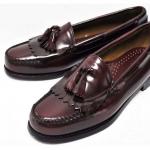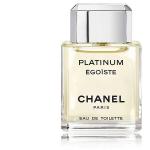Signs of good men's shoes and boots
It's time for the most difficult article in the Signs of Good Things series. Here I will try to be as simple as possible and to be as less snobbish as possible and as objective as possible. Although, alas, the main focus will still be on expensive shoes, because only they have most of the features listed below.
Leather
Good shoes are made from good leather. “Good skin”, however, is a very vague concept. Someone thinks that he can accurately determine the quality of the skin by its appearance, but it is actually very difficult to do this. Of course, definitely bad skin, with obvious defects, too rough or too thin, is quite easy to determine by appearance. However, not everyone can distinguish good quality leather from very good quality leather.
It is good if words and expressions such as calf, box calf, cordovan, full-grain appear in the descriptions of shoes or boots. And, on the contrary, it is bad if you see the words polished, corrected-grain, hi-shine.
Why? Because corrected-grain, polished, hi-shine are usually low-level leather, it undergoes cardinal processing using chemicals and looks somewhat artificial: it has a gloss, but it is plastic and "cheap"; the surface is completely uniform, glossy; skin texture is not visible. Shoes made of corrected-grain leather, respectively, do not look very advantageous; in addition, over time, they do not acquire a patina, but they are easily scratched, and often they are not very comfortable and “breathe” rather poorly. Fortunately, such shoes are easy to recognize by their appearance alone.
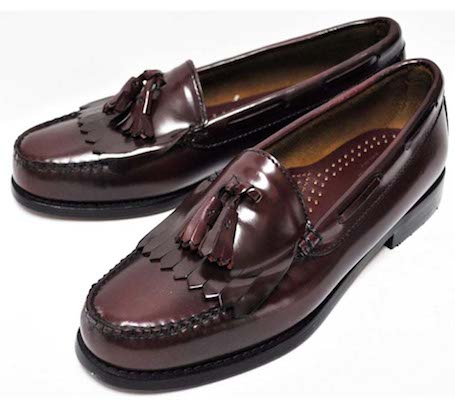 Shoes made of high-quality calfskin (calf - full-grain, box calf ...), on the contrary, look great and (with proper care) acquire a patina over time and age nobly. The texture of such skin is quite distinguishable, and normal calf skin acquires a strong shine and gloss only after a procedure called “glassage”. However, in this case, the gloss will not be as “cheap” as corrected-grain / hi-shine leather.
Shoes made of high-quality calfskin (calf - full-grain, box calf ...), on the contrary, look great and (with proper care) acquire a patina over time and age nobly. The texture of such skin is quite distinguishable, and normal calf skin acquires a strong shine and gloss only after a procedure called “glassage”. However, in this case, the gloss will not be as “cheap” as corrected-grain / hi-shine leather.
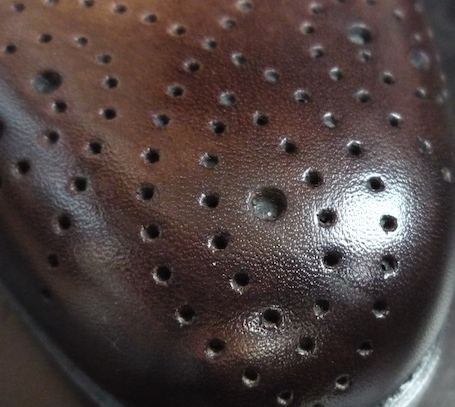 A few words about suede. Some consider suede to be a low-quality material, but this is not at all the case. It is indeed more capricious and delicate than classic smooth leather, but it is comfortable, sometimes looks great and, with proper care, can “live” for a very long time.
A few words about suede. Some consider suede to be a low-quality material, but this is not at all the case. It is indeed more capricious and delicate than classic smooth leather, but it is comfortable, sometimes looks great and, with proper care, can “live” for a very long time.
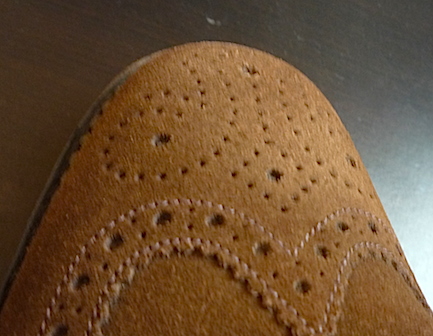 In addition to shoes made from smooth or grained calfskin or suede, there are other good options - for example, shoes made of cordovan (membrane from horse croup). If you have enough money for exotic, then you can buy it, but shoes made from real crocodile skin are very expensive. More common is a crocodile print applied to ordinary calfskin. "Crocodile" shoes for 20-30 thousand rubles are actually made of printed calfskin.
In addition to shoes made from smooth or grained calfskin or suede, there are other good options - for example, shoes made of cordovan (membrane from horse croup). If you have enough money for exotic, then you can buy it, but shoes made from real crocodile skin are very expensive. More common is a crocodile print applied to ordinary calfskin. "Crocodile" shoes for 20-30 thousand rubles are actually made of printed calfskin.
Notable tanneries
Not all shoe manufacturers indicate a tannery - a manufacturer and supplier of leather. The very fact that a tannery is indicated can serve as an argument in favor of the corresponding brand (especially if the tannery is eminent and conscientious), but if the tannery is not indicated, this does not mean that the shoes are bad.
Among the good, eminent tanneries, it is worth mentioning Annonay, du Puy, Charles F. Stead, Ilchea, Weinheimer Leder ... Read more about these and other tanneries - and remember that the same tannery can produce both very ordinary and excellent leather . Miracles do not happen: shoes for 200 euros may well be made from good leather, but they cannot be made from high-class leather.
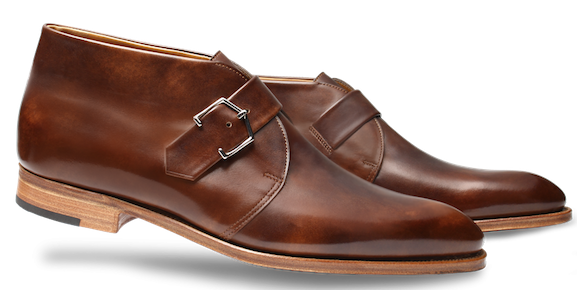
Block
Good shoes are sewn on a good last, which, as you probably guess, is also a rather vague concept (in this case, last refers to the model of the foot on which shoes are made). One last may seem comfortable to one person and terrible to another - even if the shoes fit him in size and fullness. This is understandable: after all, everyone's feet are different! Therefore, it is very desirable to try on shoes before buying.
Michael Anton gives the following way to check the quality of pads. Place your shoes next to each other and look at them from above. The right side of the left shoe and the left side of the right shoe should be almost straight, but if the shoes are turned over, there should be noticeable bends on these sides, and the outlines of the shoes themselves on the back side resemble a banana. See a couple of examples below. It should be added that such shoes may not be comfortable for you, and shoes that are not "banana-shaped" may be comfortable. Everything is individual.
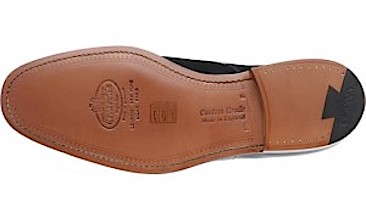
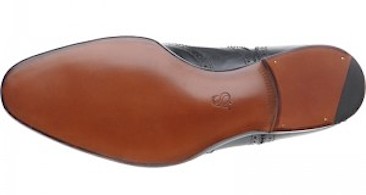 You may find that shoes made with comfortable lasts are inexpensive and expensive shoes are uncomfortable. There is nothing surprising in this, but it is obvious that you just tried on cheap shoes and few expensive ones. Some manufacturers are famous for their comfortable lasts (in fact, they are just well-designed and as “universal” as possible), and some companies, on the contrary, produce not the most comfortable shoes - more precisely, shoes that seem comfortable only to a few people.
You may find that shoes made with comfortable lasts are inexpensive and expensive shoes are uncomfortable. There is nothing surprising in this, but it is obvious that you just tried on cheap shoes and few expensive ones. Some manufacturers are famous for their comfortable lasts (in fact, they are just well-designed and as “universal” as possible), and some companies, on the contrary, produce not the most comfortable shoes - more precisely, shoes that seem comfortable only to a few people.
Sole
As a rule, budget brands do not produce shoes with leather soles. The leather sole is more expensive, and it is also more capricious. You need to put prophylaxis on it if you are going to wear shoes in wet weather. At the same time, it stands out for its excellent breathability, which is very good in summer (attention: prevention partially neutralizes this advantage). In addition, the leather sole is better combined with suits and formal clothing in general.
A huge number of companies produce shoes with leather soles, but mostly these are expensive companies: a pair of their shoes often costs more than 20 thousand rubles. Not the most expensive shoe brands that have leather-soled shoes in their assortment: Barker, Berwick, Doucal's, Grenson, John White, Lloyd (attention! They also have imitation leather soles), Meermin, Septieme Largeur, ShoePassion, Velasca.
Determining whether a shoe / boot has a leather or rubber sole is very easy. The photos above (in the lasts section) showed leather soles. They are brown and rather smooth, while the rubber soles are usually dark gray and rough. True, some brands imitate leather soles - say, Lloyd (not always) and H by Hudson.
It should be added that leather soles are different. For example, oak bark tanned soles are valued above others - shoes with them are produced by companies such as Cheaney (Imperial line), Alfred Sargent (Exclusive line) ... Look for the appropriate expression in the descriptions on the websites of brands and stores.
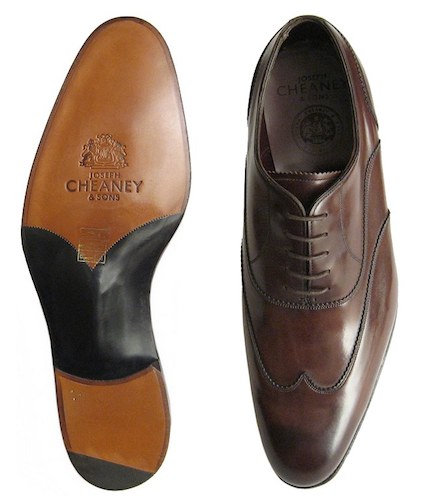 In addition, I note that, perhaps, the most famous manufacturer of leather soles is J. Rendenbach. Sometimes her logo (JR) is placed directly on the sole, sometimes not (and in this case, the Rendenbach brand may appear in the description of shoes or boots - although not always).
In addition, I note that, perhaps, the most famous manufacturer of leather soles is J. Rendenbach. Sometimes her logo (JR) is placed directly on the sole, sometimes not (and in this case, the Rendenbach brand may appear in the description of shoes or boots - although not always).
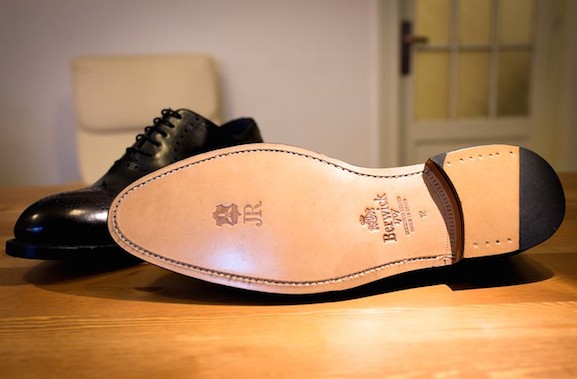 Well-known and respected rubber sole manufacturers include Dainite, Vibram, Ridgeway and Commando. Shoes with these soles are produced by Cheaney, Loake, Crockett & Jones, di Mella, Grenson, Barker and many other companies. Often the logo of the sole manufacturer can be seen right on the sole itself.
Well-known and respected rubber sole manufacturers include Dainite, Vibram, Ridgeway and Commando. Shoes with these soles are produced by Cheaney, Loake, Crockett & Jones, di Mella, Grenson, Barker and many other companies. Often the logo of the sole manufacturer can be seen right on the sole itself.
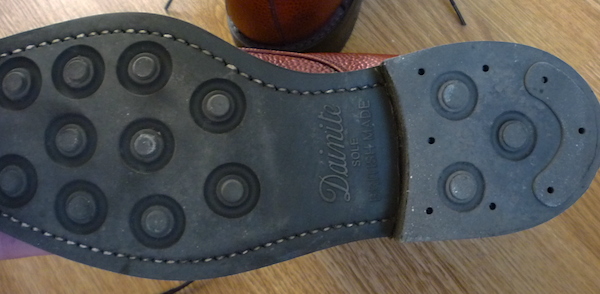 Read more about the types of soles.
Read more about the types of soles.
toes
The toes are one of those details that distinguish high-end shoes from good shoes, and good shoes from very ordinary mass-produced shoes. However, of course, the verdict will not always be true; you need to pay attention to other points. But the fact remains: the shoes of such eminent manufacturers as Corthay, Edward Green, John Lobb, Gaziano & Girling, Berluti, Aubercy, the toes look especially: they seem to be licked, they are slightly beveled, elegant and processed very carefully. Here is an example:
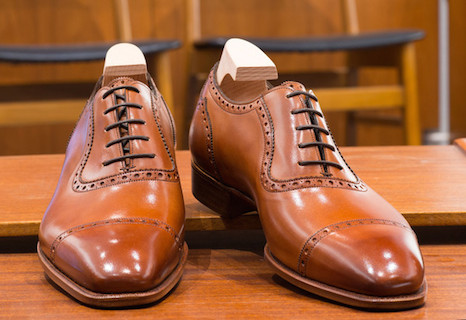 Compare this to Alden's simpler cape (don't get hung up on the shape, just look at the execution).
Compare this to Alden's simpler cape (don't get hung up on the shape, just look at the execution).
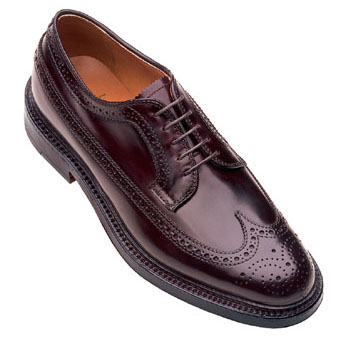 And finally, compare the capes in the above photos with the mass boot cape:
And finally, compare the capes in the above photos with the mass boot cape:
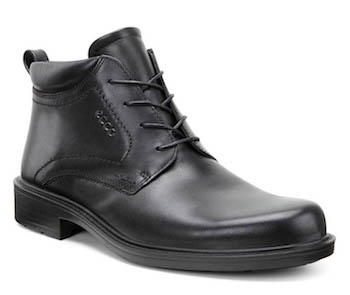
Waist
Another way to recognize high-end shoes is to look at their waist. If she fiddle (like the photo below) 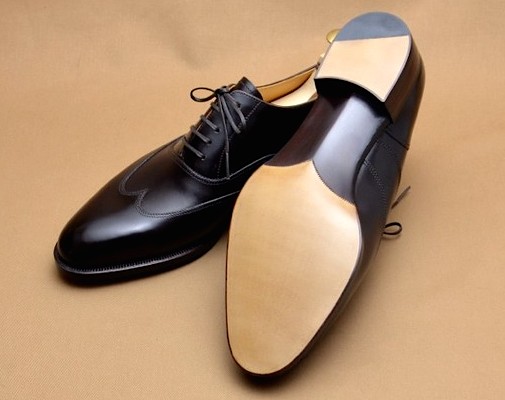 or bevelled (rounded)
or bevelled (rounded) 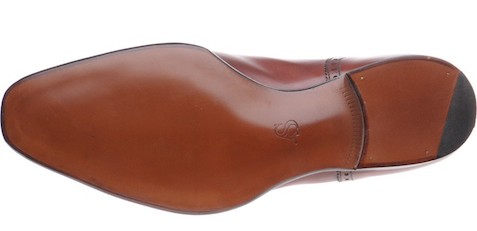 then we are talking about good shoes. But there is a caveat: even very high-quality shoes and boots can be equipped with the most ordinary waist. John Lobb (ready-to-wear) is a prime example of this. Read more about the types of waist men's shoes.
then we are talking about good shoes. But there is a caveat: even very high-quality shoes and boots can be equipped with the most ordinary waist. John Lobb (ready-to-wear) is a prime example of this. Read more about the types of waist men's shoes.
Design
One of the most reliable shoe designs is the Goodyear Welted. I wrote about it in detail in. The advantages of Goodyear Welted shoes are durability, strength, and the ability to replace the sole. Disadvantages, from the point of view of some people - old-fashioned, some massiveness. And of course, the high price.
This design has two more "fortified" varieties that provide better protection from water. These are Veldtschoen (Storm welted) and Norwegian (Norwegian welted). In addition, there is also a design that is very similar to the Goodyear Welted, but it involves a noticeably larger amount of manual work. Read more about shoe designs.
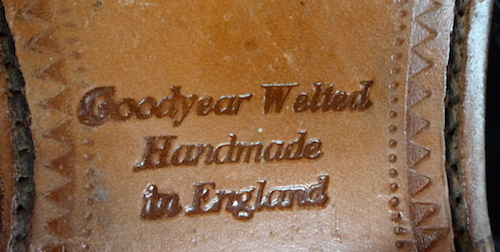 Some brands that have Goodyear Welted shoes include: Alden, Alfred Sargent, Allen Edmonds, Barker, Berwick, Carmina, Cheaney, Church's, Cleverley, Crockett&Jones, Edward Green, Foster&Son, Gaziano&Girling, Grenson, Herring, Jeffery West, J.M.Weston , John Lobb, Loake, Meermin, Paraboot, Shoe Passion, Tricker's, Yanko.
Some brands that have Goodyear Welted shoes include: Alden, Alfred Sargent, Allen Edmonds, Barker, Berwick, Carmina, Cheaney, Church's, Cleverley, Crockett&Jones, Edward Green, Foster&Son, Gaziano&Girling, Grenson, Herring, Jeffery West, J.M.Weston , John Lobb, Loake, Meermin, Paraboot, Shoe Passion, Tricker's, Yanko.
You can identify Goodyear Welted by looking at the shoes: is there a welt? Some manufacturers, however, make rubber-soled shoes with decorative welts and imitation stitching; in addition, inexperienced people may confuse the Goodyear Welted with the Blake Rapid design. However, the guarantee is often the words Goodyear Welted on the soles of the respective boots.
Read more about how to distinguish Goodyear Welted shoes from shoes of other designs.
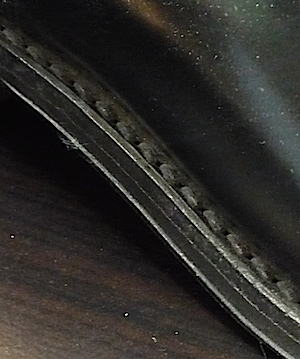
Closed channel stitching (closed seam on the sole)
As a rule, on high-end Goodyear Welted shoes, the seam on the sole is not visible: it is hidden. This technique is called closed channel stitching. It is used not only by Goodyear Welted shoe manufacturers, but also by some shoe manufacturers with a Blake construction.
![]()
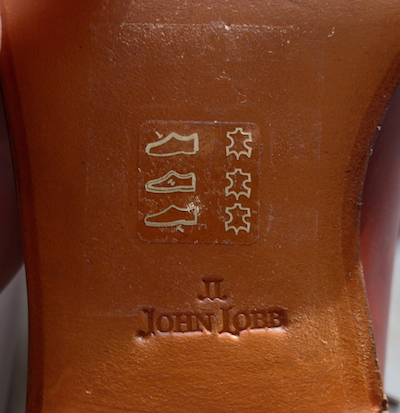 Some manufacturers offering closed channel stitching Goodyear Welted shoes are Alfred Sargent (Exclusive line), Cheaney (Imperial line), Crockett&Jones (hand grade line), Gaziano&Girling, Grenson (G Zero line), John Lobb, Tricker's (1829 and Jermyn lines). street).
Some manufacturers offering closed channel stitching Goodyear Welted shoes are Alfred Sargent (Exclusive line), Cheaney (Imperial line), Crockett&Jones (hand grade line), Gaziano&Girling, Grenson (G Zero line), John Lobb, Tricker's (1829 and Jermyn lines). street).
Stitch density
This parameter can also be used to evaluate the level of shoes, although I am not sure that it is worth attaching great importance to it. Typically, Goodyear Welted / Hand-Welted high-end shoes have a stitch density at the seam connecting the welt and the sole is 10 stitches per inch, and sometimes more (examples with 10 stitches/inch: John Lobb and Corthay). Alden and modern J.M.Weston models are around 7 stitches/inch or a little more, but older J.M.Westons go up to 9-10 stitches/inch.
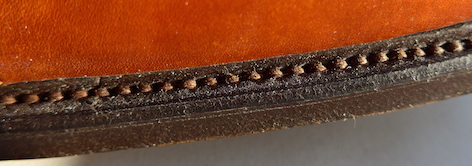 A density of 5-6 stitches / inch is typical for cheaper, but still good shoes: these are the brands Loake, Barker, Allen Edmonds, Cheaney, Paraboot, Tricker's and so on.
A density of 5-6 stitches / inch is typical for cheaper, but still good shoes: these are the brands Loake, Barker, Allen Edmonds, Cheaney, Paraboot, Tricker's and so on.
I talked more about stitch density in.
Shoes can be made unlined or lined. In the cheapest shoes, the lining is synthetic or leatherette. Expensive shoes use either linen or leather. Sometimes leather and textiles are combined. Leather is the most expensive and best lining material.
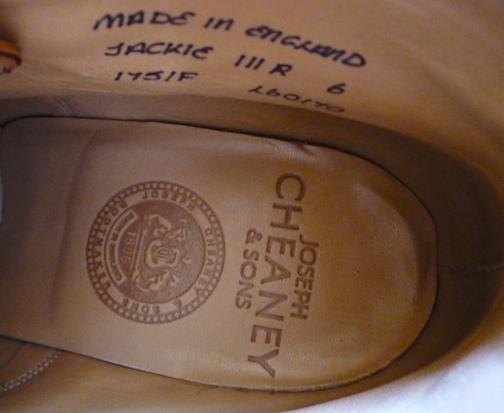 In summer shoes, leather lining may not be very useful, since it, in fact, serves as an additional heat-insulating layer. Therefore, flax is sometimes more appropriate. The most terrible thing is summer shoes with leatherette lining that does not breathe.
In summer shoes, leather lining may not be very useful, since it, in fact, serves as an additional heat-insulating layer. Therefore, flax is sometimes more appropriate. The most terrible thing is summer shoes with leatherette lining that does not breathe.
Some brands with leather lined shoes include: Alden, Alfred Sargent, Allen-Edmonds, A.Testoni, Barker, Berluti, Berwick, Brooks Brothers, Carmina, Cheaney, Church's, Crockett&Jones, Ecco, Edward Green, Fabi, Fratelli Rossetti, Franceschetti, Gaziano&Girling, Herring, Jeffery West, J.M.Weston, John Lobb, Lloyd, Loake, Marsell, Meermin, Moreschi, Nero Giardini, Paraboot, Sanders, Shoe Passion, Sutor, Tricker's, Velasca.
Remember that full leather lining is always better than 1/2 leather lining (the second option is often found in the lower lines of Barker, Loake, Church's).
Finishing / Finishing
Expensive shoes stand out with a beautiful, neat, and sometimes truly virtuoso finish. Cheap shoes and shoes of the middle price segment are easier in this regard. Finishing, on the one hand, is an exclusively decorative thing. But on the other hand, it indicates the degree of skill of shoe manufacturers, their scrupulousness and conscientiousness. The level of these qualities varies, and the level of finish also varies.
 Gypsy-style trim - rhinestones, bright brand logos, crystals, gold inserts and the like - only testifies to the bad taste of shoe manufacturers (or rather, those who ordered the production of these shoes) and nothing else.
Gypsy-style trim - rhinestones, bright brand logos, crystals, gold inserts and the like - only testifies to the bad taste of shoe manufacturers (or rather, those who ordered the production of these shoes) and nothing else.
Handmade, Benchmade
The word Handmade is often used for marketing purposes. As a rule, only custom-made shoes can be called truly handmade shoes, and they are insanely expensive (the bill often goes to thousands of euros). There are some more budget handmade ready-made shoes, but this is a rarity.
Benchmade - these are shoes and boots of a lower class than handmade, but still this is a high level compared to mass factory “stamping”. Fortunately, this word is almost never used for marketing purposes, and if you see it on shoes (for example, on the sole), then this is a significant plus in their favor.
I wrote about handmade and benchmade in detail in.
Country of Origin
Some believe that the highest quality and most durable shoes are made in England, but in France, Italy, Spain, Portugal, Hungary, Romania, the USA and other countries some firms also produce very decent shoes. Even in Asia, decent samples are sometimes made. And at the same time, you can find pretty ordinary shoes with stamps, such as Made in Italy, Made in England, Made in Romania - not to mention Made in China.
In other words, when choosing shoes, you should pay attention not so much to the country of production, but to the quality of the leather, construction, lining, last - in general, to the parameters described above.

